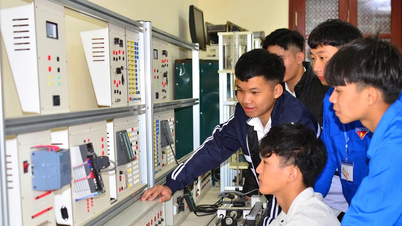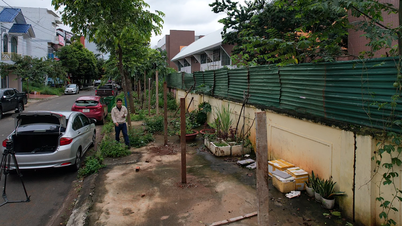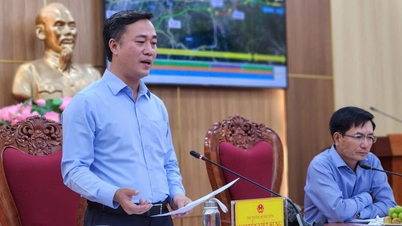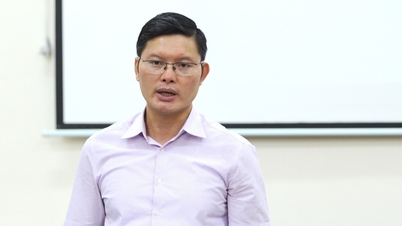
Many students attending the 2025 University and College Admission Choice Day expressed their desire to study at vocational schools - Photo: QUANG DINH
On September 18, the Ministry of Home Affairs issued Official Dispatch No. 1850 on the arrangement and streamlining of public service units according to Official Dispatch No. 59 of the Central Steering Committee on summarizing Resolution No. 18-NQ/TW 2017, which directs the merger of vocational education centers (VET) and continuing education centers (CET) into a new institution equivalent to "vocational secondary schools" under the Department of Education and Training.
No uniforms
In principle, this is a reasonable policy because it helps reduce dispersion, pool resources and unify management. However, the problem is that it should not be applied uniformly nationwide without fully studying the actual conditions of each locality.
Merging to form vocational high schools requires many factors: a staff that is both good at teaching culture and proficient in the profession, facilities and land to build schools, modern practice equipment, financial resources for operation and most importantly, a stable number of students.
If we only merge mechanically without taking into account these conditions, the biggest risk is to create "school shells" that lack vitality inside.
The nature of the Continuing Education Center is very different from the vocational high school. Continuing Education is the "second door" of the education system, serving those who missed the opportunity to study formally, young workers who need to supplement their culture to go to work or export labor, adults who want to improve their knowledge, improve soft skills, foreign languages, and information technology. The strength of Continuing Education lies in its flexibility, studying in evening shifts, weekends, scattered seasons or by credit.
Meanwhile, the vocational high school model focuses on full-time, formal training, enrolling students right after junior high school, guiding students along a 3-4 year path. If we just "frame" everything into a formal program, the target groups that are the main customers of GDTX will be left out.
The working poor cannot afford to quit their day jobs to attend classes during the week, and adults who want to take short-term courses will have difficulty finding a place in the rigid curriculum. Thus, the lifelong learning goal that GDTX is undertaking will be difficult to maintain.
Another problem is resources. To form a true vocational high school requires large investments in vocational practice equipment, workshops, laboratories, internship areas, and qualified teachers.
Merging only on paper without financial resources is like building a house without a foundation.
Even in large provinces and cities, building a standard vocational school is a burden on the budget. Moreover, in remote areas, where the demand for vocational training is not high and resources are limited, establishing a vocational secondary school can become a burden and is not necessarily an effective solution.
A uniform policy will easily lead to a situation where there are schools named but no students, and facilities but they are not fully exploited.
Which way?
Instead of imposing uniformly, it is necessary to allow localities to choose appropriate models based on specific conditions. In large provinces and cities with abundant student resources, strong demand for streaming, budget and equipment conditions, the establishment of vocational or technical high schools is feasible.
But in small localities, a more feasible solution is to build satellite branches of a central college located in a large city or to organize affiliated branches.
This model takes advantage of the college's staff, equipment and programs; local students can still study close to home; reduces initial investment costs; and is more flexible in opening and closing majors according to market demand.
In addition, in each newly established vocational high school, if any, there should also be a separate "GDTX block" with a cultural supplementary program and short-term training courses.
This will be a combination of the formal model and the open model, serving both post-secondary students and not forgetting special groups of learners such as freelancers, adults, and workers needing degrees.
If we fail to maintain this flexibility, we risk losing an important piece of the national education system: the piece of lifelong learning and second chances for learners.
In short, merging vocational education and continuing education is necessary, but turning them into vocational high schools everywhere is not necessarily appropriate.
Furthermore, the National Assembly has not yet passed the revised Law on Vocational Education, the concept of vocational secondary school may not yet exist legally, even the concept of "vocational training facility" should be called by its correct name "vocational education facility".
Good policy must be based on careful study of social needs, local resources and regional characteristics. Decisions should not be made in a uniform, top-down fashion.
The central government needs to outline general guidelines, while the choice of model, scale, and organizational form should be delegated to localities so that each place can find its own suitable solution.
If that can be done, the merger will be truly effective; but if we only focus on form, the risk of waste and formalization is very high. There used to be markets but no people to attend the market, just like there were schools but no students like in the past, this is an expensive lesson today.
Consider the social consequences
If the new model does not maintain flexibility, it is likely that the group of poor workers and adults who need additional education to go to work or work abroad will be eliminated from the system.
This is contrary to the policy of expanding learning opportunities for everyone, building a learning society and lifelong learning.
In addition, forced consolidation can also cause psychological disruption for teachers, affecting the team that is accustomed to the management mechanism, curriculum and teaching methods of two different systems. Without a plan to train and retrain the team, the quality of training will be difficult to ensure.
Maximum 3 fields
"... Merge vocational education centers and continuing education centers into vocational secondary schools equivalent to high schools under the Department of Education and Training to provide public career services in inter-ward and commune areas. Each province or centrally-run city shall have a maximum of three vocational schools (not including schools that are self-sufficient in regular expenditure or higher)".
(Excerpt from Official Dispatch 8150 on the arrangement of public service units)
Source: https://tuoitre.vn/hinh-thanh-trung-hoc-nghe-can-nghien-cuu-ky-tranh-ap-dung-dong-loat-20251002090213678.htm







![[Photo] Binh Trieu 1 Bridge has been completed, raised by 1.1m, and will open to traffic at the end of November.](https://vphoto.vietnam.vn/thumb/1200x675/vietnam/resource/IMAGE/2025/10/2/a6549e2a3b5848a1ba76a1ded6141fae)

































































































Comment (0)